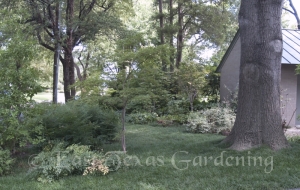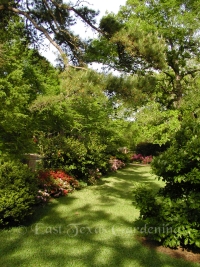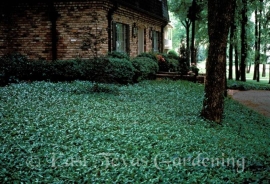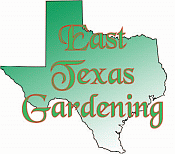Made in the Shade
by Keith C. Hansen
“Nothing will grow under the trees in my yard!”
Sound familiar? Blessed with a climate and soils conducive to vigorous growth of trees, shade is common factor for most East Texans. Rather than looking at shade as a liability, use it as an asset to enhance your landscape.
_thmb.jpg) Most shade complaints stem from the fact that grass will not grow well in dense shade. All turfgrasses perform best in full sun. St. Augustine is the most shade tolerant grass, while Centipede will tolerate partial shade. But, some trees cast such heavy shade that no grass will thrive in that dark environment. This is particularly true for areas under evergreen trees such as live oak, pine and magnolia. Even deciduous trees with large leaves, like oaks, can have such dense canopies that little sunlight penetrates to the ground.
Most shade complaints stem from the fact that grass will not grow well in dense shade. All turfgrasses perform best in full sun. St. Augustine is the most shade tolerant grass, while Centipede will tolerate partial shade. But, some trees cast such heavy shade that no grass will thrive in that dark environment. This is particularly true for areas under evergreen trees such as live oak, pine and magnolia. Even deciduous trees with large leaves, like oaks, can have such dense canopies that little sunlight penetrates to the ground.
Rather than curse the shade, be thankful for the cooling benefit your trees provide. Without it, your electric bill would be substantially higher and it would be much more unpleasant to venture outside in the heat of summer.
There are many plants that are adapted to shady sites. If you are struggling, trying to grow a lawn under a grove of trees, consider a different approach by adding variety and class to your lot with plants that thrive in the shade.
 Green will be the basic color you will have to work with in developing a shade garden since most flowering plants do best in partial or full sun. But, that doesn’t mean your garden needs to be dull! Varying leaf textures, from the refined look of ferns, to the bold, broad leaves of elephant ears and aspidistra or cast iron plant, help make an ordinary garden bed look special.
Green will be the basic color you will have to work with in developing a shade garden since most flowering plants do best in partial or full sun. But, that doesn’t mean your garden needs to be dull! Varying leaf textures, from the refined look of ferns, to the bold, broad leaves of elephant ears and aspidistra or cast iron plant, help make an ordinary garden bed look special.
And there is more than one shade of green. Variegated leaves add cream, yellow or white to the basic green color palate. Plus, there is a good selection of shade-loving plants for adding color through beautiful blooms.
 Not all shade is equal. Plant selection for shade is based on the degree of absence of sunlight. Full or deep shade occurs under low branching trees, trees with large leaves and evergreen trees. The north side of buildings and fences can also have deep shade, especially if a tree is nearby. Open or filtered shade can be found under tall, high-branching trees with small leaves or near walls and fences without overhead branches. Some areas may receive shade only half of the day, such as the edge of a wooded area or the west or east side of a house or fence. Select your plants based on the type of shade you have.
Not all shade is equal. Plant selection for shade is based on the degree of absence of sunlight. Full or deep shade occurs under low branching trees, trees with large leaves and evergreen trees. The north side of buildings and fences can also have deep shade, especially if a tree is nearby. Open or filtered shade can be found under tall, high-branching trees with small leaves or near walls and fences without overhead branches. Some areas may receive shade only half of the day, such as the edge of a wooded area or the west or east side of a house or fence. Select your plants based on the type of shade you have.
Here is a sampling of plants worthy of consideration to give you an idea of what is available. Many in the following list can be classified as ground covers which can be used as a lawn replacement. Visit your local nursery for more ideas on developing an ideal retreat from the summertime heat.
English Ivy is a common ground cover for a shaded location. It thrives in deep shade, and once established, will cover a large area with a thick carpet of deep green. There are several varieties available with varying leaf shapes. English Ivy will grow up tree trunks, and I recommend not allowing it grow on the trunks. While it doesn't hurt the tree trunk, it can get away from you and grow into the branches, creating excessive shade and weight on the limbs. Although it is a nuisance plant in other parts of the country, our experience in Texas is that it does not get out of control, invasively spreading into unmanaged woodlands.
 Asian jasmine (Trachelospermum asiaticum) makes a dense cover in both sun and heavy shade. It is one of the most used groundcovers due to tough nature, cold hardiness, and pest-free nature. There are several different cultivars, including some variegated varieties including Summer and Snow and Ogon Nishiki (better known as Salsa). A good place to see different types is in the Gatewood Garden on the north side Jenkins Hall on the Tyler Junior College campus.
Asian jasmine will also eventually grow up tree trunks in the east Texas area and I suggest you don't let it get started. It is a strong spreader and therefore I do not recommend it for small areas.
Asian jasmine (Trachelospermum asiaticum) makes a dense cover in both sun and heavy shade. It is one of the most used groundcovers due to tough nature, cold hardiness, and pest-free nature. There are several different cultivars, including some variegated varieties including Summer and Snow and Ogon Nishiki (better known as Salsa). A good place to see different types is in the Gatewood Garden on the north side Jenkins Hall on the Tyler Junior College campus.
Asian jasmine will also eventually grow up tree trunks in the east Texas area and I suggest you don't let it get started. It is a strong spreader and therefore I do not recommend it for small areas.
 Hostas or Plantain Lilies make a bold statement in the shade garden with their large, richly colored leaves. Hostas are herbaceous perennials, disappearing in late fall or winter only to return from the same roots the following spring, more robust than the year before. Hostas grow 8 to 18 inches tall in large clumps and sport tall spikes of flowers in summer. There are many varieties with varying leaf colors and shapes. ‘Sugar and Cream’, ‘So Sweet’, ‘Blue Cadet’, ‘Royal Standard’, 'Guacamole', and ‘Blue Angel’ are a few of the varieties that flourished in our hosta variety trial at the Tyler Rose Garden.
Hostas or Plantain Lilies make a bold statement in the shade garden with their large, richly colored leaves. Hostas are herbaceous perennials, disappearing in late fall or winter only to return from the same roots the following spring, more robust than the year before. Hostas grow 8 to 18 inches tall in large clumps and sport tall spikes of flowers in summer. There are many varieties with varying leaf colors and shapes. ‘Sugar and Cream’, ‘So Sweet’, ‘Blue Cadet’, ‘Royal Standard’, 'Guacamole', and ‘Blue Angel’ are a few of the varieties that flourished in our hosta variety trial at the Tyler Rose Garden.
Liriope is a grass-like perennial that grows in dense, low clumps in full shade or partial sun and bear lilac colored flowers which are followed by black fruit. There are several varieties, including giant and variegated liriope. The liriope bordering the beds in the Camellia Garden area in the Tyler Rose Garden show how it can be used as border. Liriope muscari is a clumping form, while Liriope spicata spreads by underground runners, which makes it a better choice for quickly filling in larger area. L. muscari can also be used as a ground cover, but needs to be closely spaced to provide a continuous cover. There are several varieties of both species, ranging from short, tall, chartreuse to variegated.
A close relative is monkey or mondo grass (Ophiopogon) which forms dense clumps that spread by underground stems. The foliage of common mondo grass is dark green, and there is a variety with almost black leaves. Dwarf mondo grass is a very low growing variety, suitable for growing between the cracks in stepping stones.
Ferns are classic plants for shade. There are many species of ferns to select from – both native and exotic. Most ferns prefer a moist environment and are perfect for the woodland garden. Their light, airy texture provides an excellent contrast to the broad leaves of most plants. Some common types include holly fern, painted fern, royal fern, lady fern, sensitive fern, wood or river fern and autumn fern. See my article on ferns for more information.
Here’s a few other shrubs and ground covers that would prefer a shady location in your yard: acuba, aspidistra, camellia, holly (many species), Florida anise (Illicium floridanum), Oregon grapeholly (Mahonia), leatherleaf mahonia, Japanese fatsia, fatshedera, wintercreeper (Euonymus fortunei), ajuga, variegated Japanese sedge (Carex), inland sea oats (best suited for naturalizing as it readily reseeds), and azaleas.
For a splash of color, try some of the following annuals, perennials and bulbs: impatiens, New Guinea impatiens, begonias, caladiums, Chinese ground orchid (Bletilla), columbine, achimenes (‘Purple King’), firespike (Odontonema strictum), coleus, phlox, violets and spring-blooming bulbs such as narcissus.
- southern magnolia and ophiopogon groundcover (2)
Southern magnolia casts heavy shade but instead of struggling to grow turf underneath, mondograss has made a nice groundcover.
- dallas_shade
This shady landscape is dominated by green at this time of year, yet its design is inviting and cooling.
- shade patterns 5
Not only is the section have broken shade due to high branching trees, but as the sun moves through out the day (and during the year), the shade constantly shifts. Careful observation during a sunny day, and consideration of the changing sun angles from summer to winter will result in succesful selection of appropriate plants.
- asian_jasmine
Asian jasmine is great for covering large areas, whether in full shade as in this yard, or in full sun.
- hosta Guacamole and Sugar and Cream
Hosta 'Guacamole' (foreground) and 'Sugar & Cream' in the background are two varieties that look great and done well for many years in northeast Texas.

